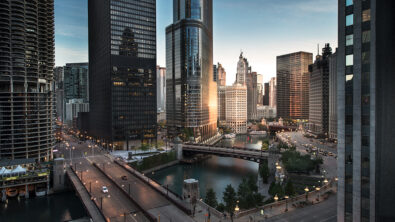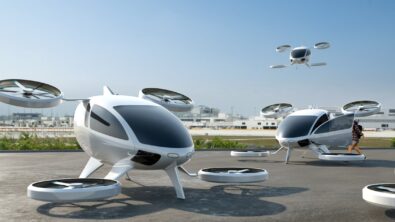Rethinking Infrastructure for AAM Part Two – Summary

Vertiports are the core pillar for future advanced air mobility (AAM) infrastructure. A cross between a bus station and a helicopter pad, a vertiport is a designated place for aerial vehicles such as air taxis to land, take off from, and pick up or deliver passengers and cargo, , as well as recharge when not in use. If AAM fleets are to be integrated in urban areas, many vertiports will need to be constructed to make those fleets a viable method of transportation.
Of course, vertiports impose their own unique design considerations compared to other forms of transportation infrastructure. Their recharging capabilities would require a consistent, reliable source of sustainable energy. There is the question of where exactly they would be constructed in cities, and how location would influence both the design of vertiports and aircraft.
In the latest episode of Talking Aerospace Today, Todd Tuthill, Vice President of Aerospace & Defense (A&D) for Siemens Digital Industries Software, is joined again by John Nixon, his fellow Vice President of Energy, Chemicals, and Infrastructure, to continue discussing the challenges of AAM infrastructure. Together, they identify novel energy methods that can be used for vertiports, design priorities for vertiports, and the role of the digital twin in optimizing AAM vehicles for vertiports in urban environments.
Powering vertiports
As mentioned in the previous episode, many AAM designs are planning to use electric batteries to be sustainable, yet that sustainability factor means nothing if the energy to charge those batteries comes from fossil fuels. Vertiports themselves must be sustainable as well.
To accomplish this, John identifies a variety of sustainable distributed energy resources (DERs) vertiports can be powered with, including rooftop solar panels, small wind turbines, and onsite battery storage systems. Another option currently being developed is small modular reactors (SMRs), a new way to utilize nuclear energy at smaller, safer, and more manageable levels. All these options provide low-carbon ways ideal for power vertiports.
These technologies are also perfect for developing microgrids for vertiports. While the burden vertiports would impose on the electrical grid would not be significant, according to the previous episode, there is still the chance of the grid being unreliable. One option to circumvent that issue would be to give vertiports their own microgrids, smaller, localized grids that can operate independently from the main grid. Added with any of the sustainable technologies mentioned above, microgrids can give vertiports a reliable, green source of power to support AAM fleets with.
Where to place vertiports
The next question in constructing vertiports would probably be where to place them. In order to make AAM a viable form of transportation, there would need to be enough vertiports to ensure there is always one in close proximity for passengers. One place Todd suggests is the tops of parking garages, which are already close to places of importance in cities and hubs of transportation.
Wherever a vertiport it placed, however, companies building them must ensure they are designed for quick and easy access, for both passengers and those servicing the vertiports themselves. Passengers will want to enter a vertiport, find an air taxi, and take off in as short a timespan as possible. Meanwhile, a parking garage with tight turns and corridors filled with parked cars may be a difficult environment for a maintenance truck carrying parts for a 50-foot wingspan air taxi to drive through. Vertiports, therefore, will need to be designed not only for usability by customers, but also serviceability by operators and maintainers.
Designing air taxis for vertiports
The factors will also have an impact on the design of AAM vehicles directly. According to Todd, a modular approach to AAM vehicle design, making parts easy to access, take apart, and put back together, might be ideal, especially if those parts are being transported through dense urban areas and enclosed parking garages.
This is an area the digital twin can assist in. As a virtual representation of a product, engineers can create a digital twin of a modular air taxi and analyze how parts could move and come off before ever building a physical prototype. Additionally, the digital twin can be simulated, utilizing data from the virtual product and data from the physical world to digitally replicate the air taxi in transit, allowing engineers to optimize their part designs using real-world data.
There are still many challenges to solve with vertiports and AAM infrastructure, but there are just as many potential solutions. With sustainable technologies and clear design priorities, bolstered by the digital twin, companies can build vertiports in a way to make AAM a new, reliable form of aerial transportation
Stay tuned for the next episode of Talking Aerospace Today more on digital transformation’s role in building AAM infrastructure.
Siemens Digital Industries Software helps organizations of all sizes digitally transform using software, hardware and services from the Siemens Xcelerator business platform. Siemens’ software and the comprehensive digital twin enable companies to optimize their design, engineering and manufacturing processes to turn today’s ideas into the sustainable products of the future. From chips to entire systems, from product to process, across all industries. Siemens Digital Industries Software – Accelerating transformation.


